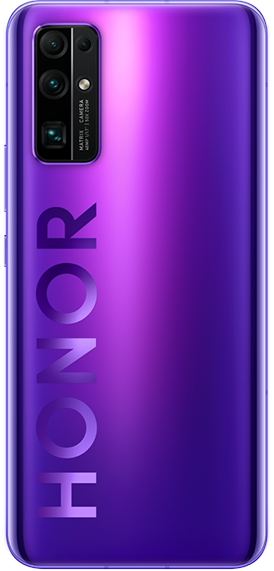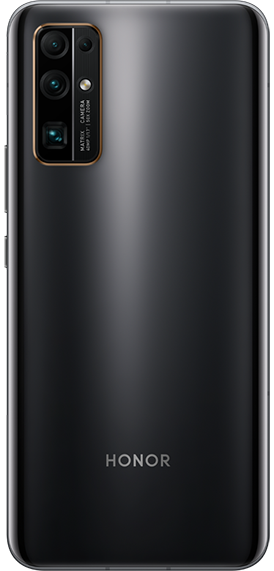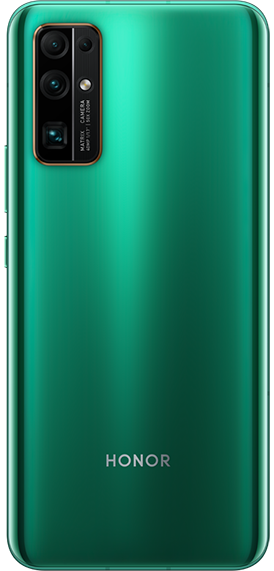Just a few days ago, Honor launched the Honor 30S in China, making it the first device in the new 30-series. Now, the company has launched the Honor 30, 30 Pro and 30 Pro+ in China, fully unveiling its latest flagship lineup for China. With the flagship HiSilicon Kirin 990 SoC across the board, the three phones offer enough choices between them for people in the region who want a competitive phone. The main focus of the phones is the camera setup, and there’s enough to pack a punch.

Honor 30 series: Specifications
| Specifications |
Honor 30 |
Honor 30 Pro |
Honor 30 Pro+ |
| Dimensions & Weight |
- 160.34 x 74.18 x 8.10 – 8.47 mm
- 185g
|
- 160.32 x 73.61 x 8.38 – 8.63 mm
- 186g
|
- 160.32 x 73.61 x 8.38 – 8.63 mm
- 186g
|
| Display |
- 6.53″ FHD+ curved OLED
- 2400 x 1080; 20:9
- DCI-P3
- Single punch hole
|
- 6.57″ FHD+ curved OLED
- 2340 × 1080, 19.5:9
- DCI-P3
- Elongated punch hole
|
- 6.57″ FHD+ curved OLED
- 2340 × 1080, 19.5:9
- 90Hz refresh rate
- 180Hz touch sampling rate
- DCI-P3
- Elongated punch hole
|
| SoC |
HiSilicon Kirin 985, 7nm:
- 1x Cortex-A76 based core @ 2.58GHz
- 3x Cortex-A76 based core @ 2.40GHz
- 4x Cortex-A55 based core @ 1.84GHz
Mali G77
|
HiSlicon Kirin 990, 7nm EUV:
- 2x Cortex-A76 based core @ 2.86GHz
- 2x Cortex-A76 based core @ 2.36GHz
- 4x Cortex-A55 based core @ 1.95GHz
Mali G76
|
HiSlicon Kirin 990, 7nm EUV:
- 2x Cortex-A76 based core @ 2.86GHz
- 2x Cortex-A76 based core @ 2.36GHz
- 4x Cortex-A55 based core @ 1.95GHz
Mali G76
|
| RAM & Storage |
- 6GB + 128GB
- 8GB + 128GB
- 8GB + 256GB
Not expandable
|
Expandable via nano-memory card
|
Expandable via nano-memory card
|
| Battery & Charging |
- 4,000 mAh
- 40W SuperCharge fast wired charging
- 40W charger included
|
- 4,000 mAh
- 40W SuperCharge fast wired charging
- 40W charger included
|
- 4,000 mAh
- 40W SuperCharge fast wired charging
- 40W charger included
- 27W fast wireless charging
- Support reverse wireless charging
|
| Rear Camera |
Photo:
- Primary: 40MP, f/1.8, 1/1.7″ RYYB sensor, OIS
- Secondary: 8MP, ultra-wide-angle, f/2.4
- Tertiary: 8MP, periscope, f/3.4, 5x optical zoom, OIS
- Quarternary: 2MP, macro, f/2.4
Video:
- 4K @ 30fps
- 720p @ 960fps super slow motion
|
Photo:
- Primary: 40MP, f/1.8, 1/1.7″ RYYB Sony IMX600 sensor, OIS
- Secondary: 16MP, ultra-wide-angle, f/2.2, fixed focus
- Tertiary: 8MP, periscope, f/3.4, 5x optical zoom, OIS
- Other: LAF, CAF, PDAF
Video:
- 4K @ 60fps
- 1080p @ 960fps super slow motion
|
Photo:
- Primary: 50MP, f/1.9, 1/1.28″ RYYB Sony IMX700 sensor, OIS
- Secondary: 16MP, ultra-wide-angle, f/2.2, autofocus
- Tertiary: 8MP, periscope, f/3.4, 5x optical zoom, OIS
- Other: LAF, CAF, PDAF
Video:
- 4K @ 60fps
- 1080p @ 960fps super slow motion
- 720p @ 1920fps super slow motion
|
| Front Camera |
32MP, f/2.0 |
- 32MP, f/2.0
- 8MP, f/2.2, ultra-wide
|
- 32MP, f/2.0
- 8MP, f/2.2, ultra-wide
|
| Other Features |
- Wi-Fi 802.11 a/b/g/n/ac
- Bluetooth 5.1
- NFC
- Dual nano-SIM
- 5G SA/NSA
|
- Wi-Fi 802.11 a/b/g/n/ac/ax
- Bluetooth 5.1
- NFC
- Dual nano-SIM
- 5G SA/NSA
- IP54 water and dust resistance
- USB 3.0
|
- Wi-Fi 802.11 a/b/g/n/ac/ax
- Bluetooth 5.1
- NFC
- Dual nano-SIM
- 5G SA/NSA
- IP54 water and dust resistance
- USB 3.0
|
| Android Version |
Magic UI 3.1 based on Android 10 |
Magic UI 3.1 based on Android 10 |
Magic UI 3.1 based on Android 10 |
Honor 30
While the overall design language is the same across the lineup, the Honor 30 is the outlier among the three in terms of specifications as it has a few noticeable changes.
For instance, you get a smaller display-diagonal but a slightly larger aspect ratio. The hole punch for the camera only needs to house a single 32MP front camera, so it is smaller. The display quality is OLED and is curved on the sides, which is the same as the other two. There’s no high refresh rate option though, which is a bummer.


On the inside, the Honor 30 is powered by the new HiSilicon Kirin 985 which is a 5G-capable SoC. RAM options are 6GB and 8GB, whereas you can get 128/256GB of internal storage, non-expandable. The battery on the device is a healthy 4,000 mAh, which supports 40W Huawei SuperCharge with the included charger. There’s no wireless charging on the device.




The rear camera setup on the Honor 30 comprises of four cameras, which is actually one more than the other two phones. The highlight of the setup is the 40MP 1/1.7″ RYYB sensor with f/1.8 aperture. This is complemented by a 8MP ultra-wide-angle camera, an 8MP periscope camera for 5x optical zoom with OIS, and a dedicated 2MP macro shooter.
Honor 30 Pro and Honor 30 Pro+
The Honor 30 Pro and Honor 30 Pro+ are very similar devices, but they too, have some key differences between them.
The basic design is the same across both the phones. The dimensions of the phones match, and the display diagonal is also the same at 6.57″. What does differ between the two is the fact that the Pro+ comes with a 90Hz refresh rate, while the Pro is just 60Hz. The touch sampling rate also sees a bump up to 180Hz. The front camera on both the phones sits within the elongated pill that is hole-punched within the display, to accommodate the 32MP main front camera and 8MP ultra-wide-angle front camera.




On the inside, both the phones are powered by the flagship Kirin 990 SoC. RAM is restricted to 8GB on the Pro, while the Pro+ also offers a 12GB variant. Storage can be expanded on both the phones through Huawei’s proprietary nano-memory cards. The battery on the phones is a 4,000 mAh, and it also supports 40W SuperCharge for fast wired charging. The Pro+ also packs in wireless charging capabilities up to 27W, as well as support for reverse wireless charging. Both the phones also get USB 3.0 support through the Type-C port. They also have support for WiFi 6, and come with IP54 certification for water and dust resistance.
The rear camera is where the differences widen. The main sensor on the Pro is the same as the Honor 30, which is the 40MP 1/1.7″ Sony IMX600 RYYB sensor. On the other hand, the Pro+ ups the game even further with the 50MP, f/1.9, 1/1.28″ RYYB Sony IMX700 sensor which is even larger, along with OIS. The second camera is a 16MP ultra-wide-angle with fixed focus on the Pro, while the Pro+ gets autofocus and macro mode capabilities. The rest of the setup is the same on both, including the 8MP periscope camera, and support for LAF, CAF, and PDAF. The difference in hardware on the Pro+ lets it capture 4K video @ 60fps, as well as 720p @ 1920fps super slow motion in addition to 1080p @ 960fps. There’s also AI RAW features that captures multiple RAW shots and then blends them into one RAW image for further editing.
Pricing and Availability
The Honor 30 and 30 Pro will be available in three standard colors: White, Black, and Green, and in two logo-inscribed colors: Purple, and Silver. The Honor 30 Pro+ will be available in two standard colors: Black, and Green, and in one logo-inscribed color: Silver.

The phones will be available in the following variants:
- Honor 30:
- 6GB + 128GB: CNY 2,999 ($425)
- 8GB + 128GB: CNY 3,199 ($453)
- 8GB + 256GB: CNY 3,499 ($496)
- Honor 30 Pro:
- 8GB + 128GB: CNY 3,999 ($566)
- 8GB + 256GB: CNY 4,399 ($623)
- Honor 30 Pro+:
- 8GB + 256GB: CNY 4,999 ($708)
- 12GB + 256GB: CNY 5,499 ($779)
Currently, the phones are restricted to the Chinese region. Availability and pricing for regions outside of China are unknown at this stage.
What are your thoughts on the Honor 30 series? Do you want to see them made available outside of China? Let us know your thoughts in the comments below!
The post Honor 30, Honor 30 Pro and Honor 30 Pro+ launched in China appeared first on xda-developers.
from xda-developers https://ift.tt/2RG3s4t
via
IFTTT


























